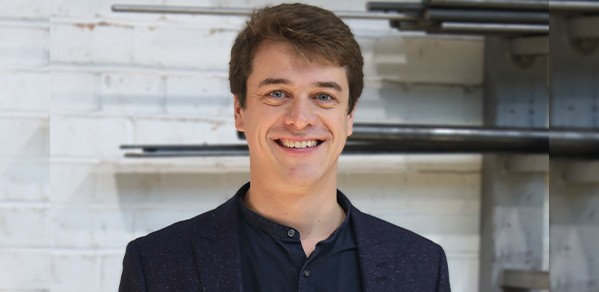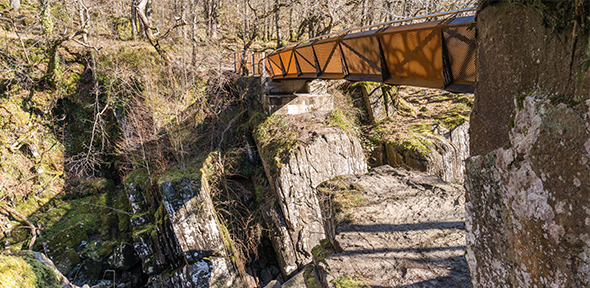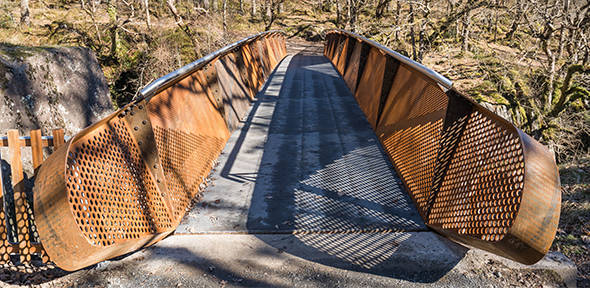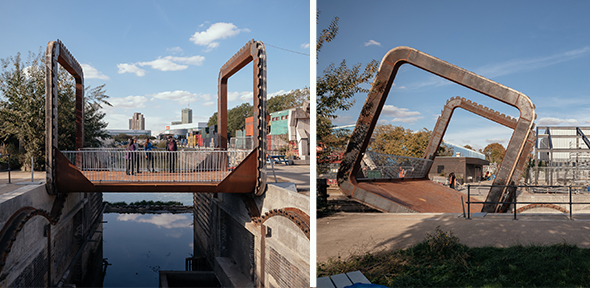
“To be a structural engineer means to be a creator: our ideas become reality.” These are the words of alumnus David Knight, Director of Design and Engineering at Cake Industries, who has recently been announced as the 2023 Early Career Prize winner by the International Association for Bridge and Structural Engineering (IABSE).
David is an outstanding young leader of our profession and an inspiring role model for his generation. His commitment to pursuing excellence in engineering design and construction is of the highest standard, and he is a very effective ambassador for structural engineering.
IABSE award citation
It is an accolade that David says is humbling, given that the prize is presented to an individual member, 40 years of age or younger, for outstanding achievement in structural engineering.
The citation reads: “Presented to David Knight, UK, for excellence in structural design, combining artistic and aesthetic flair with engineering expertise within a framework of efficient manufacture and construction to deliver outstanding outcomes across a wide range of engineering structures.
“David is an outstanding young leader of our profession and an inspiring role model for his generation. His commitment to pursuing excellence in engineering design and construction is of the highest standard, and he is a very effective ambassador for structural engineering. His combination of artistic and architectural skills with engineering excellence is powerful and effective, as seen in all his work.
“Making high-value, beautiful objects and focusing on craft skills combined with cutting-edge computational work is the hallmark of David's work, and this Award demonstrates the vital importance of high-quality structural engineering in making the world a better place.”
David, who studied a Master of Engineering (MEng) at Cambridge, from 2003-07, specialising in Civil and Structural Engineering, has also been a guest lecturer at the Department of Engineering. He currently works with architects, designers, artists and contractors to create bridges, sculpture, staircases, pavilions and other architectural features. Among his designs are several award-winning bridges, many of which have been opening bridges where the synergy of structural, mechanical and architectural design has been a factor.
We asked David, of all his bridge designs, which one is his favourite?
He replied: “That’s like being asked to pick your favourite child! I have two: the Bracklinn Falls Footbridge, spanning 22 metres across the Keltie Water at the Bracklinn Falls, in the Loch Lomond and Trossachs National Park, Scotland, and the Cody Dock Rolling Bridge – a pedestrian bridge in East London, spanning eight metres, which rotates via manual levers to let boats pass.
“Bracklinn Falls Footbridge is the most satisfying scheme, as everything needed to be so efficient and multi-use to suit a site that was incredibly difficult to access and build at. It also had to be beautiful to fit into the stunning natural site and therefore, we developed an innovative modular system that used the best of computer-controlled design, as well as being extremely structurally efficient (with very high sustainability credentials). I was also responsible as both lead designer and main contractor to actually get the bridge delivered, and so it felt very personal!


Bracklinn Falls Footbridge. Credit: Paul Saunders Photography.
“Cody Dock Rolling Bridge was a once-in-a-career experience because it was so unusual. It needed the whole team to step outside their normal responsibilities and try and make an idea work in reality. I led the fabrication and construction team alongside an architectural designer and a structural engineer, but we left our labels at the door, and the final scheme has all of us in every detail. Some of the most vital work was done by a more recent Department of Engineering graduate, Alfred Jacquemot, who developed the complex mathematical model of how the bridge rolled!”

Cody Dock Rolling Bridge. Credit: Jim Stephenson.
Additionally, David has been involved in the design of the Greenwich Reach Swing Bridge over Deptford Creek, alongside the River Thames, which spans 44 metres; and the fabrication and installation of the Dinosaur Swing Bridge in Crystal Palace Park – an eight metre-long moving bridge.
So, what makes an award-winning bridge?
“A bridge at its basic level is simply a method of getting from one side of a gap to another. However, a bridge can also have a much wider impact as part of a larger piece of infrastructure or route or as an object in a landscape.
“Bridges often have to satisfy multiple constraints (usability and function, constructability, durability, sustainability, aesthetic quality) whilst remaining as simple and as light as possible (to minimise material use and/or cost). The highest quality bridges satisfy all constraints and then have something more to give. There is nowhere to hide as a designer – all your decisions are on show!”
What is the best part of being a structural engineer?
“Our ideas become reality. It is a rush to touch something that you imagined and designed, knowing that your skills were instrumental in bringing it into being. It is really rewarding work.
“It is also a role where you have a huge impact on the climate crisis; new objects and projects at the scale we work at have a massive carbon output. This means that the influence of our design work can make a big difference to improving the overall carbon outcome, saving many multiples of our own personal footprint by doing our work well.”
What are the challenges facing your industry as focus is turned towards a net zero future?
“I am a member of the Net Zero Bridges Group in the UK, its mission being to help lead the way towards a net zero future.
“There are huge challenges. ‘Business as usual’ type operations with incremental improvements are just not going to be enough to reach net zero, and yet there is a large amount of inertia to changing our business models to suit a more regenerative and sustainable approach. We need to push harder and faster, and the only way to do that is by collaborating with all of the other professions to set mutual goals; we cannot act alone.”
What does it mean to you to be awarded the IABSE Early Career Prize?
“I am honoured, delighted and slightly overawed. This prize has a history of extraordinary winners and to be added to the list is humbling in the extreme. It is also a little false to award prizes to individuals in construction and engineering, as nothing can be built without a huge team. Therefore, it is a recognition of the many collaborators that I have worked with on all of my projects! I get a real buzz out of working with others to make something better than we could achieve on our own.”
How did Cambridge help set you up for your future career?
“The breadth of experiences at Cambridge and particularly the engineering course was vital. My career has taken many twists and turns, and the appreciation you get for other disciplines and the ability to understand enough them to integrate it into the design, has proved really important.
“The other vital thing was being around others (both in the Department of Engineering and more widely in extracurricular activity) with diverse viewpoints who would challenge your way of thinking. It is a great place to learn to be collaborative.
“If I were to sum up my Cambridge experience in three words, I would describe it as challenging, invigorating and formative.”
Adapted from an IABSE press release.

